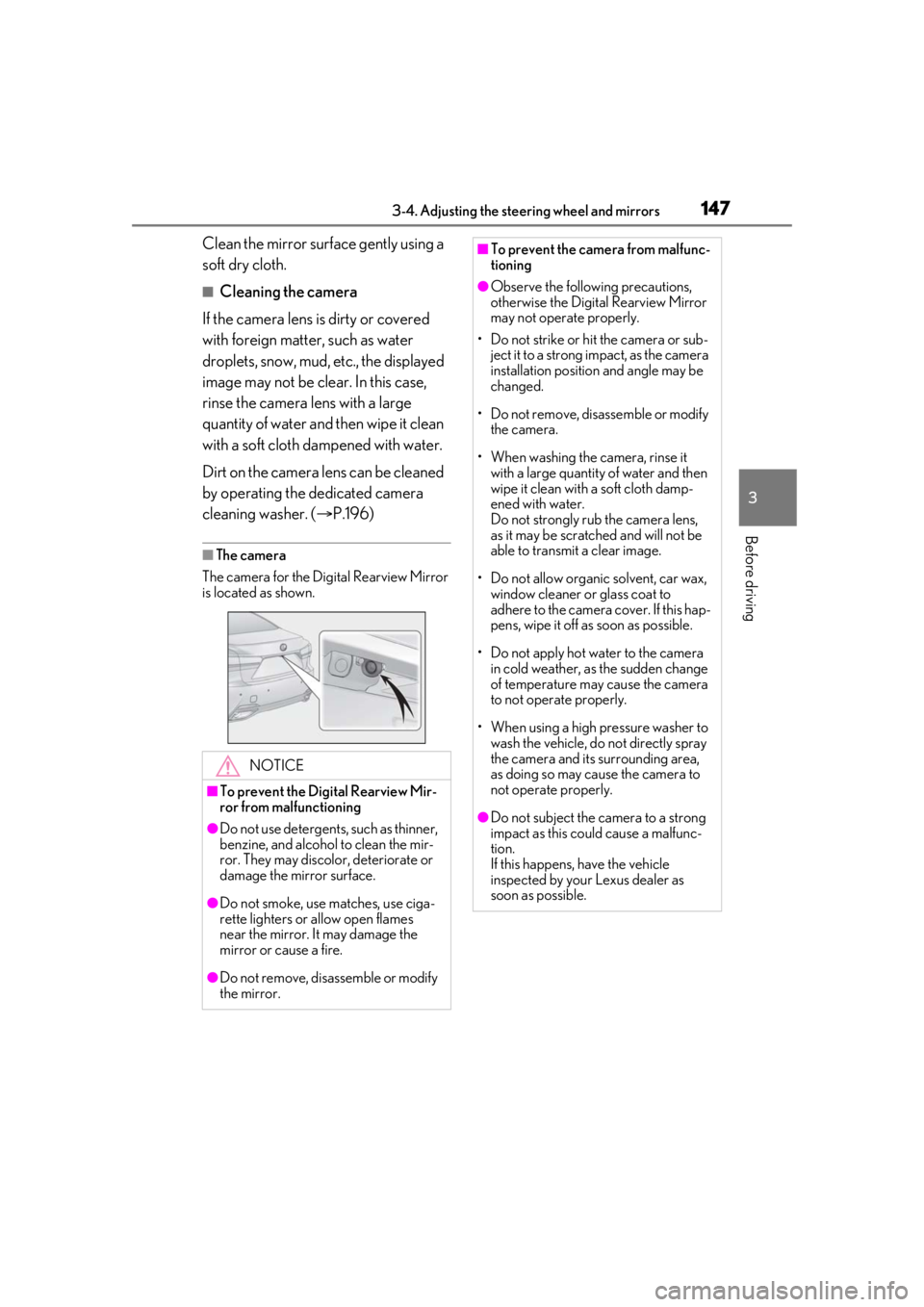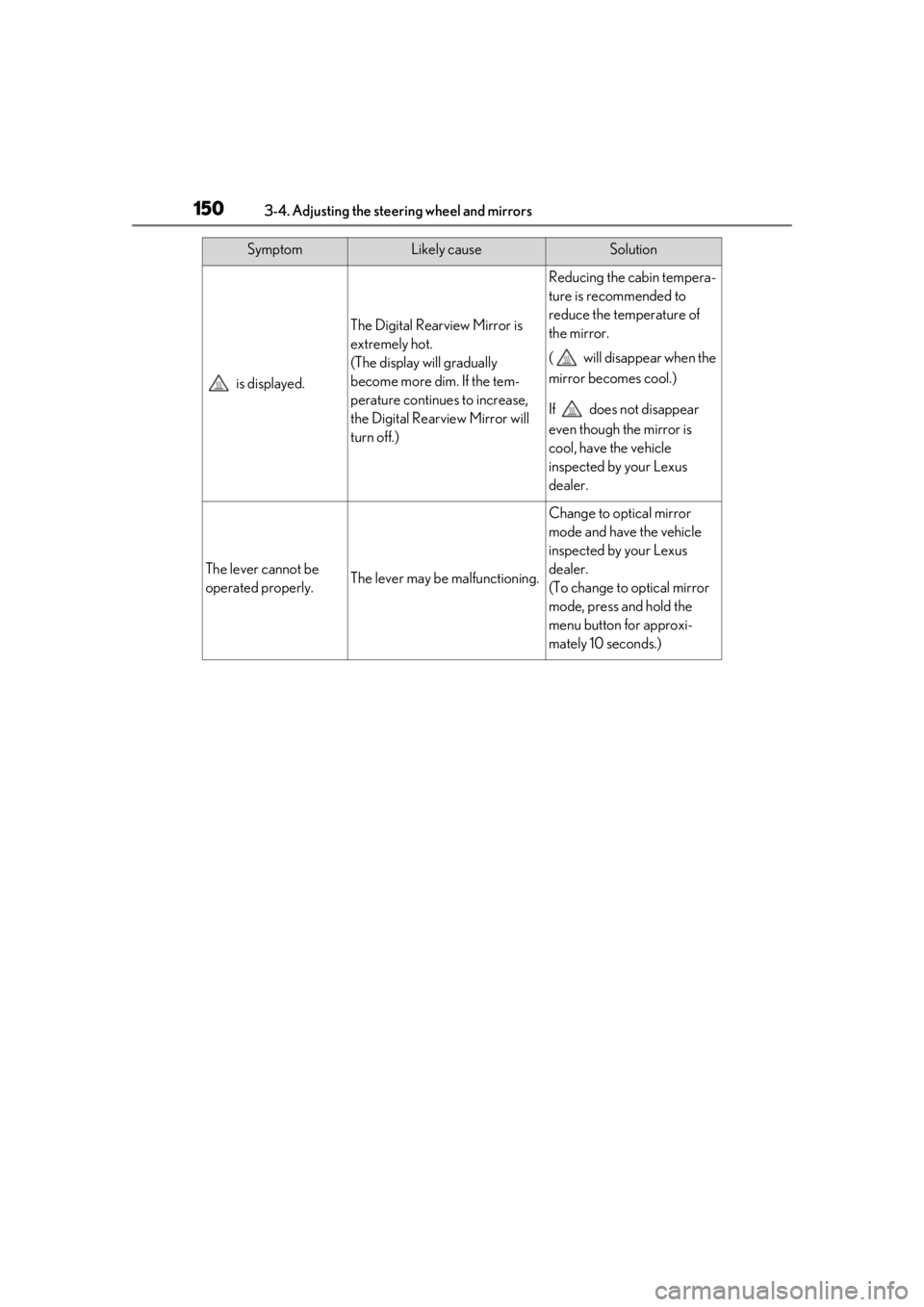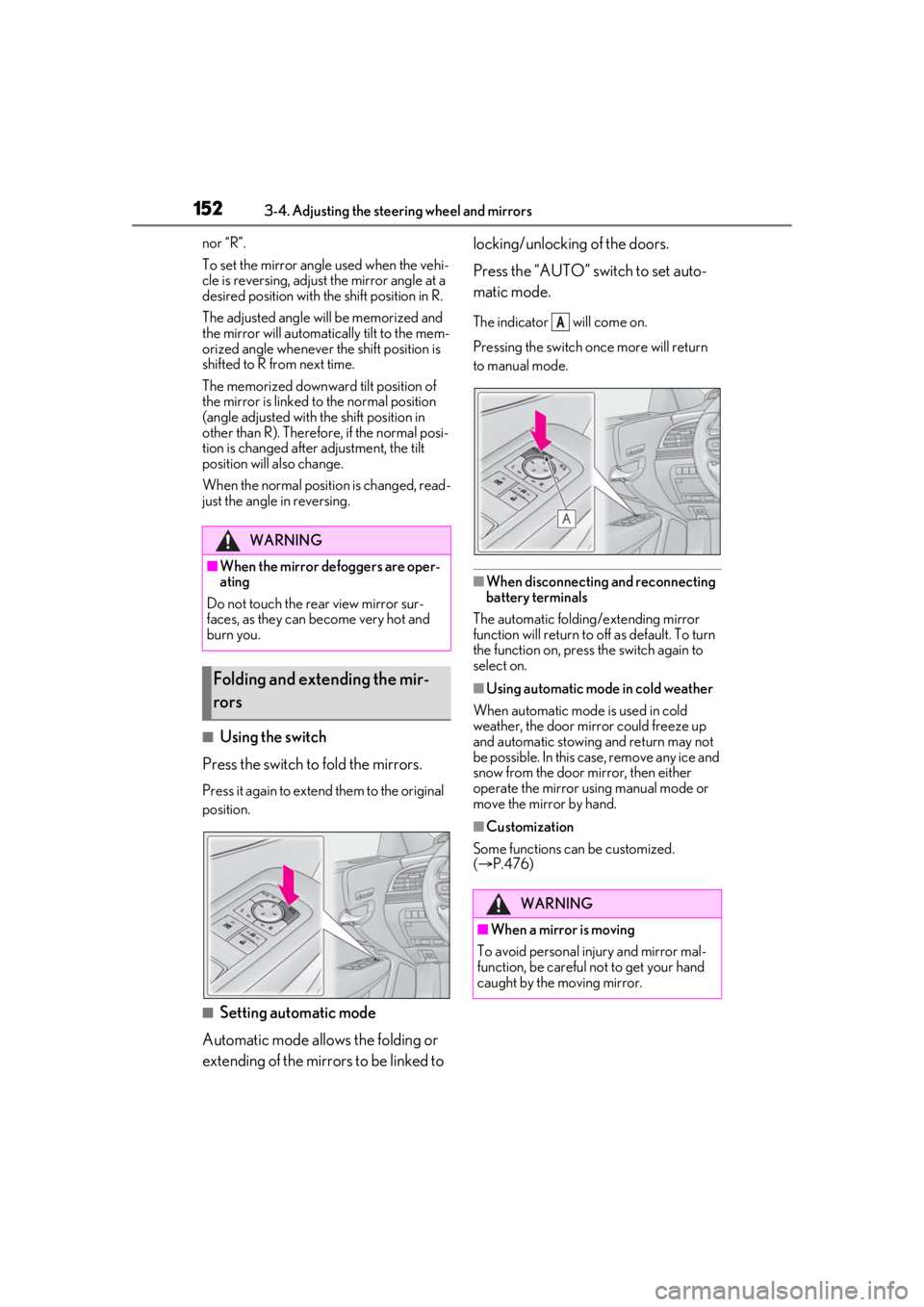2021 LEXUS LS500 steering
[x] Cancel search: steeringPage 147 of 520

1473-4. Adjusting the steering wheel and mirrors
3
Before driving
Clean the mirror surface gently using a
soft dry cloth.
■Cleaning the camera
If the camera lens is dirty or covered
with foreign matter, such as water
droplets, snow, mud, etc., the displayed
image may not be clear. In this case,
rinse the camera lens with a large
quantity of water and then wipe it clean
with a soft cloth dampened with water.
Dirt on the camera lens can be cleaned
by operating the dedicated camera
cleaning washer. ( P.196)
■The camera
The camera for the Digital Rearview Mirror
is located as shown.
NOTICE
■To prevent the Digital Rearview Mir-
ror from malfunctioning
●Do not use detergents, such as thinner,
benzine, and alcohol to clean the mir-
ror. They may discolor, deteriorate or
damage the mirror surface.
●Do not smoke, use matches, use ciga-
rette lighters or allow open flames
near the mirror. It may damage the
mirror or cause a fire.
●Do not remove, disassemble or modify
the mirror.
■To prevent the camera from malfunc-
tioning
●Observe the following precautions,
otherwise the Digital Rearview Mirror
may not operate properly.
• Do not strike or hit the camera or sub- ject it to a strong impact, as the camera
installation position and angle may be
changed.
• Do not remove, disassemble or modify the camera.
• When washing the camera, rinse it with a large quantity of water and then
wipe it clean with a soft cloth damp-
ened with water.
Do not strongly rub the camera lens,
as it may be scratched and will not be
able to transmit a clear image.
• Do not allow organic solvent, car wax,
window cleaner or glass coat to
adhere to the camera cover. If this hap-
pens, wipe it off as soon as possible.
• Do not apply hot water to the camera in cold weather, as the sudden change
of temperature may cause the camera
to not operate properly.
• When using a high pressure washer to wash the vehicle, do not directly spray
the camera and its surrounding area,
as doing so may cause the camera to
not operate properly.
●Do not subject the camera to a strong
impact as this could cause a malfunc-
tion.
If this happens, have the vehicle
inspected by your Lexus dealer as
soon as possible.
Page 148 of 520

1483-4. Adjusting the steering wheel and mirrors
If you notice any of the following symptoms, refer to the following table for the likely
cause and the solution.
If the symptom is not resolved by the solu tion, have the vehicle inspected by your
Lexus dealer.
If you notice any symptoms
SymptomLikely causeSolution
The image is difficult to
see.
The mirror surface is dirty.Clean the mirror surface
gently, using a soft dry cloth.
Sunlight or headlights are shining
directly into the Digital Rearview
Mirror.
Change to optical mirror
mode.
(If the light is coming through
the moon roof or panoramic
moon roof, close the sun-
shade.)
• The vehicle is in a dark area.
• The vehicle is near a TV tower, broadcasting station, electric
power plant, or other location
where strong radio waves or
electrical noise may be pres-
ent.
• The temperature around the camera is extremely high/low.
• The ambient temperature is extremely low.
• It is raining or humid.
• Sunlight or headlights are shin- ing directly into the camera
lens.
• The vehicle is under fluores- cent lights, sodium lights, mer-
cury lights, etc.
• Exhaust gas is obstructing the
camera.
Change to optical mirror
mode.
(Change back to digital mir-
ror mode when the condi-
tions have improved.)
Page 149 of 520

1493-4. Adjusting the steering wheel and mirrors
3
Before driving
The image is difficult to
see.Foreign matters (such as water
droplets, snow, mud, etc.) is on
the camera lens.
Operate the dedicated
camera cleaning washer
and clean the camera lens.
( P.196)
Change to optical mirror
mode.
Rinse the camera with a
large quantity of water,
wipe it clean with a soft
cloth dampened with water,
and then change back to
digital mirror mode.
The image is out of
alignment.
The trunk is not fully closed.Fully close the trunk.
The camera or its surrounding
area has received a strong
impact.Change to optical mirror
mode and have the vehicle
inspected by your Lexus
dealer.
The display is dim and
is displayed.
The system may be malfunction-
ing.
Change to optical mirror
mode and have the vehicle
inspected by your Lexus
dealer.
goes off.
SymptomLikely causeSolution
Page 150 of 520

1503-4. Adjusting the steering wheel and mirrors
is displayed.
The Digital Rearview Mirror is
extremely hot.
(The display will gradually
become more dim. If the tem-
perature continues to increase,
the Digital Rearview Mirror will
turn off.)
Reducing the cabin tempera-
ture is recommended to
reduce the temperature of
the mirror.
( will disappear when the
mirror becomes cool.)
If does not disappear
even though the mirror is
cool, have the vehicle
inspected by your Lexus
dealer.
The lever cannot be
operated properly.The lever may be malfunctioning.
Change to optical mirror
mode and have the vehicle
inspected by your Lexus
dealer.
(To change to optical mirror
mode, press and hold the
menu button for approxi-
mately 10 seconds.)
SymptomLikely causeSolution
Page 151 of 520

1513-4. Adjusting the steering wheel and mirrors
3
Before driving
1To select a mirror to adjust, press
the switch.
The indicator comes on.
Left
Right
Pressing the same switch again will put the
switch in neutral.
2To adjust the mirror, press the
switch.
Up
Right
Down
Left
■Mirror angle can be adjusted when
The engine switch is in ACCESSORY or
IGNITION ON mode.
■Defogging the mirrors
The outside rear view mirrors can be
cleared using the mirror defoggers. Turn on
the rear window defogger to turn on the
outside rear view mirror defoggers.
( P.324)
■Auto anti-glare function
When the anti-glare inside rear view mirror
is set to automatic mode, the outside rear
view mirrors will activate in conjunction with
the anti-glare inside rear view mirror to
reduce reflec ted light. (P.142, 145)
■Automatic adjustment of the mirror
angle
A desired mirror face angle can be entered
to memory and recalled automatically by
the driving position memory. ( P.133)
■Linked mirror function when reversing
When either “L” or “R” of the mirror select
switch is selected, the outside rear view mir-
rors will automatically angle downwards
when the vehicle is re versing in order to
give a better view of the ground.
To disable this function, select neither “L”
Outside rear view mirrors
The rear view mirror’s position can
be adjusted to enable sufficient
confirmation of the rear view.
WARNING
■Important points while driving
Observe the following precautions while
driving.
Failure to do so may result in loss of con-
trol of the vehicle and cause an accident,
resulting in death or serious injury.
●Do not adjust the mirrors while driving.
●Do not drive with the mirrors folded.
●Both the driver and passenger side
mirrors must be extended and prop-
erly adjusted before driving.
Adjustment procedure
A
B
A
B
C
D
Page 152 of 520

1523-4. Adjusting the steering wheel and mirrors
nor “R”.
To set the mirror angle used when the vehi-
cle is reversing, adjust the mirror angle at a
desired position with the shift position in R.
The adjusted angle will be memorized and
the mirror will automatically tilt to the mem-
orized angle whenever the shift position is
shifted to R from next time.
The memorized downward tilt position of
the mirror is linked to the normal position
(angle adjusted with the shift position in
other than R). Therefore, if the normal posi-
tion is changed after adjustment, the tilt
position will also change.
When the normal position is changed, read-
just the angle in reversing.
■Using the switch
Press the switch to fold the mirrors.
Press it again to extend them to the original
position.
■Setting automatic mode
Automatic mode allows the folding or
extending of the mirrors to be linked to locking/unlocking of the doors.
Press the “AUTO” switch to set auto-
matic mode.
The indicator will come on.
Pressing the switch on
ce more will return
to manual mode.
■When disconnecting and reconnecting
battery terminals
The automatic folding/extending mirror
function will return to off as default. To turn
the function on, press the switch again to
select on.
■Using automatic mode in cold weather
When automatic mode is used in cold
weather, the door mirror could freeze up
and automatic stowing and return may not
be possible. In this case, remove any ice and
snow from the door mirror, then either
operate the mirror using manual mode or
move the mirror by hand.
■Customization
Some functions can be customized.
( P.476)
WARNING
■When the mirror defoggers are oper-
ating
Do not touch the rear view mirror sur-
faces, as they can become very hot and
burn you.
Folding and extending the mir-
rors
WARNING
■When a mirror is moving
To avoid personal injury and mirror mal-
function, be careful not to get your hand
caught by the moving mirror.
A
Page 164 of 520

1644-1. Before driving
4-1.Before driving
■Starting the engine
P.174
■Driving
1 With the brake pedal depressed,
shift the shift position to D.
(P.178)
Check that the shift position indicator
shows D.
2 If the parking brake is in manual
mode, release the parking brake.
(P.186)
3 Gradually release the brake pedal
and gently depress the accelerator
pedal to accelerate the vehicle.
■Stopping
1 With the shift position in D, depress
the brake pedal.
2 If necessary, set the parking brake.
If the vehicle is to be stopped for an
extended period of time, shift the shift posi-
tion to P. ( P.180)
■Parking the vehicle
1 With the shift position in D, depress
the brake pedal to stop the vehicle
completely.
2 If the parking brake is in manual
mode, set the parking brake.
(P.186)
3 Shift the shift position to P.
(P.180)
Check that the shift position indicator
shows P and the parking brake indicator is
illuminated.
4 Press the engine switch to stop the
engine.
5 Slowly release the brake pedal.
6 Lock the door, making sure that you
have the electronic key on your
person.
If parking on a hill, block the wheels as
needed.
■Starting off on a steep uphill
1 Make sure that the parking brake is
set and shift the shift position to D.
2 Gently depress the accelerator
pedal.
3 Release the parking brake.
■Driving in the rain
●Drive carefully when it is raining, because
visibility will be reduced, the windows
may become fogged-up, and the road
will be slippery.
●Drive carefully when it starts to rain,
because the road surface will be espe-
cially slippery.
●Refrain from high speeds when driving on
an expressway in the rain, because there
may be a layer of wa ter between the tires
and the road surface, preventing the
steering and brakes from operating prop-
erly.
■Engine speed while driving
In the following conditions, the engine
speed may become high while driving. This
is due to automatic up-shifting control or
down-shifting implementation to meet driv-
ing conditions. It does not indicate sudden
acceleration.
●The vehicle is judged to be driving uphill
or downhill
●When the accelerato r pedal is released
●When the brake pedal is depressed
Driving the vehicle
The following procedures should be
observed to ensure safe driving:
Driving procedure
Page 166 of 520

1664-1. Before driving
WARNING
●Do not drive the vehicle over or stop
the vehicle near flammable materials.
The exhaust system and exhaust gases
can be extremely hot. These hot parts
may cause a fire if there is any flamma-
ble material nearby.
●Vehicles without Lexus Safety System
+ A: During normal driving, do not turn
off the engine. Turning the engine off
while driving will not cause loss of
steering or braking control, but the
power assist to these systems will be
lost. This will make it more difficult to
steer and brake, so you should pull
over and stop the vehicle as soon as it
is safe to do so.
However, in the event of an emer-
gency, such as if it becomes impossible
to stop the vehicle in the normal way:
P.418
●Vehicles with Lexus Safety System + A:
During normal driving, do not turn off
the engine. Turning the engine off
while driving will not cause loss of
steering or braking control, however,
power assist to the steering will be lost.
This will make it more difficult to steer
smoothly, so you should pull over and
stop the vehicle as soon as it is safe to
do so.
In the event of an emergency, such as if
it becomes impossible to stop the vehi-
cle in the normal way:
P.418
●Use engine braking (downshift) to
maintain a safe speed when driving
down a steep hill.
Using the brakes continuously may
cause the brakes to overheat and lose
effectiveness. (
P.178)
●Do not adjust the positions of the
steering wheel, the seat, or the inside
or outside rear view mirrors while driv-
ing.
Doing so may result in a loss of vehicle
control.
●Always check that all passengers’
arms, heads or other parts of their
body are not outside the vehicle.
●Do not drive in excess of the speed
limit. Even if the legal speed limit per-
mits it, do not drive over 85 mph (140
km/h) unless your vehicle has
high-speed capability tires. Driving
over 85 mph (140 km /h) may result in
tire failure, loss of control and possible
injury. Be sure to consult a tire dealer
to determine whether the tires on your
vehicle are high-speed capability tires
or not before driving at such speeds.
■When driving on slippery road sur-
faces
●Sudden braking, acceleration and
steering may cause tire slippage and
reduce your ability to control the vehi-
cle.
●Sudden acceleration, engine braking
due to shifting, or changes in engine
speed could cause the vehicle to skid.
●After driving through a puddle, lightly
depress the brake pedal to make sure
that the brakes are functioning prop-
erly. Wet brake pads may prevent the
brakes from functioning properly. If the
brakes on only one side are wet and
not functioning properly, steering con-
trol may be affected.
■When shifting the shift position
●Do not let the vehicle roll backward
while a forward driving position is
selected, or roll forw ard while the shift
position is in R.
Doing so may cause the engine to stall
or lead to poor brake and steering
performance, resulting in an accident
or damage to the vehicle.
●Do not shift the shift position to P while
the vehicle is moving.
Doing so can damage the transmission
and may result in a loss of vehicle con-
trol.